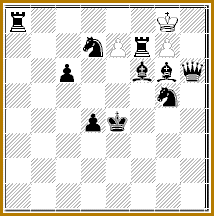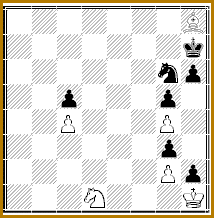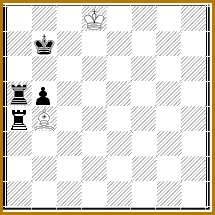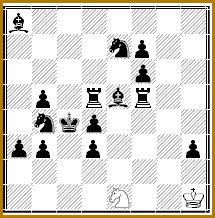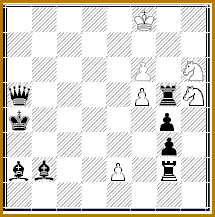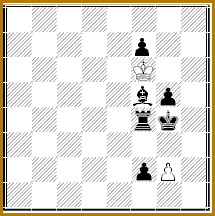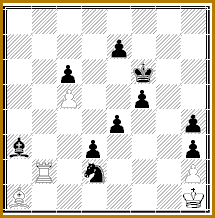from magazine SUOMEN TEHTÄVÄNIEKAT n.5-6/1999The following entries participated the tourney: 663v, 693, 694, 728-730, 764-769, 825-831, 877-881, 906, and h#5 on p. 150 (ST 5/95), all in all 26 problems.
The Problems 769 and 830 were cooked. In 877, there were two changes for a twin, which must be considered an unmotivated deviation from the common practice.
No direct anticipations have been presented, nor were such found by Hans Gruber, who performed a partial check. Yet, the chameleon echo of 878 with two wSs has been done often, and there are dozens of examples with the material wKSS vs bK + one black man.
I found it difficult to appreciate problems which, although technically faultless - chameleon echos included - had neither content in terms of strategy, nor artistic value.
In my opinion, the level of entries was not particularly high and, consequently, the number of awarded problems is small. Ranking the awarded problems proved also difficult, because even in the top problems some flaws can be found.
1. Prize: 828 (ST 4-5/95) Mikael Grönroos (FIN)
1. Prize
Mikael Grönroos (FIN)
H#4 0.1.1... 3+10
b) bPd4->d5 ; c) bSg5->a5a) 1.- e8B 2.Rf8+ gxf8R 3.Be5 Rf3 4.Sf8 Bxc6#
b) 1.- e8S 2.Qh8+ gxh8Q 3.Bd8 Qc3 4.Rf4 Sd6#
c) 1.- e8Q+ 2.Kd5 Qc8 3.Sf8 gxf8S 4.c5 Qe6#
Black check in the initial position does not disturb, since white has to play 1 .e8-anyway. The rest of the solutions then were much harder for me to find. There is lack of analogy between the solutions, but the binding element is that wP promotes into a piece of the same type as the unit it captures. Model mates.
2. Prize
Mikael Grönroos (FIN)
H#5 0.1.1... 6+71.- Ba1 2.Sf8 Sb2 3.Kg7 Sd3+ 4.Kg6 Bh8 5.Sh7 Se5# 2. Prize: 829 (ST 4-5/95) Mikael Grönroos (FIN)
Only one solution, but one with a lot of content. WB starts with a critical move, returning later to its square of departure; bK makes a tempo move and swops places with bS.
There would be H#3, if only white had a tempo move. Since there is none, white has to waste two moves, black one.
3. Prize
Miroslav Henrych (CZE)
H#4 2+41 .Ka6 Be7 2.Rb4 Kc7 3-Raa4 Bd8 4.Ka5 Kb7# 3. Prize: 728 (ST 2/95) Miroslav Henrych (CZE)
No anticipation were reported to this successive Platzwechsel of 5 pieces in miniature. WB moves pericritically, eventually becoming the rear piece of a battery after an anticipatory interference of the battery line by wK.
1. HM
Unto Heinonen (FIN)
H#4 2.1.1... 2+151 .Rc5+ Sg2 2.Sed5 Sf4 3.Sc3+ Sd5 4.Rf3 Sb6#
1 .Rd6+ Sf3 2.Kd5 Sd2 3.Ke6+ Se4 4.Sbd5 Sc5#1. Honourable Mention: 730 (ST 2/95) Unto Heinonen (FIN)
Two fine solutions, in both of which wS is unpinned twice. The idea is not quite novel though. The route of S is subtly determined, especially in the solution 1.Rd6+. Quite a lot of black men are employed.
2. HM
Toma Garai (USA)
H#4 2.1.1... 6+81 .Ka3 Sxg3 2.Rxg3 Sxg4 3.Rb3 Se3 4.Qa4 Sc2#
1 .Bb3 Sxg4 2.Rxg4 Sxg3 3.Rb4 Se4 4.Ba3 Sc3#2. Honourable Mention: 879 (ST 6/95) Toma Garai (USA)
In the two solutions the functions of wS reciprocate, showing the popular Zilahi theme, i. e. the mating piece in one solution is captured in the other, and vice versa. Both solutions end with model mates.
1. Mention
Ilkka Sarén (FIN)
H#5 3.1.1... 2+61.Rf3 Ke5 2.Rh3 Kd4 3.Rh5 Ke3 4.Kh4 Kf3 5.Bh3 g3#
1.Kg3 Kxg5 2.Rh4 Kf6 3.Rh5 Ke5 4.Kh4 Kf4 5.Bh3 g3#
1.Kh4 Ke5 2.Bh3 Kd5 3.Rf6 Ke4 4.Rh6 Kf3 5.Rh5 g3#1. Mention: 766 (ST 3/95) Ilkka Sarén (FIN)
In an economical setting the three solutions with a unique move order end with model mates. BR has three different routes to h5. The overall impression is, however, a little monotonous.
2. Mention: 880 (ST 6/95) Jorma Pitkanen (FIN)
2. Mention
Jorma Pitkanen (FIN)
H#4 2.1.1... 5+101.f4 Rb7+ 2.Kf5 Bh8 3.e6 Rg7 4. Ke5 Rg5#
1.Ke6 Rxd2 2.Bc1 Rxd3 3.Bf4 Rd4 4.Ke5 Rd6#
In one solution Indian, in the other "Pseudo-Indian", both with battery mates.December 10th, 1999 at Saariselka
Hannu Harkola
National Judge for Chess CompositionThe award published in Finnish in the issue 5-6/1999 of Suomen Tehtavaniekat. Claims by July 31 , 2000, to Kari Valtonen, Kuninkaankatu 39 A 7, FIN-33200 Tampere, Finland.
Ritorna a Vito Rallo's Home Page
